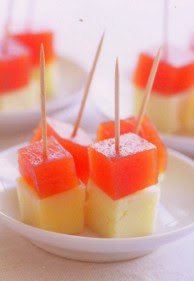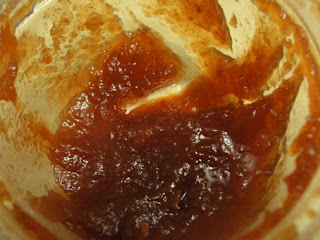A Long Day's Journey into Mid-Afternoon
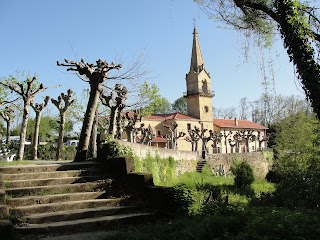
Leaving Hondarribia was easily accomplished, but taxing. Beginning on the outskirts of the town the Way went essentially straight up. When I got to the Sanctuario de Guadelupe, I was ready for a good rest.
I'd already consumed my water and I was only about four kilometres into it. I'd been able to see the Sanctuary almost the whole way up the near-cliff like slopes of Monte Jaizkabel. In the neatly groomed suburbs, I came upon an early morning ambulance call for an elderly man. Nothing like a heart attack to start your day, and nothing like the reminder of human frailty to start your Camino Proper. On my walk, I saw only one other pilgrim, a middle-aged bearded man with a huge backpack, who caught up with me as I was peering through the windows of a small ermita about halfway up. I said hello, but he didn't acknowledge me.
I needed to fill my bottles, but hesitated at the fountain in the courtyard of the sanctuary. The icon showed a tap with a stroke through it, and after the digestive woes of the first camino, I didn't want any trouble. A local man who was resting on a bench while his wife went inside to make her devotions assured me that the water from the fountain was in fact, fantastic, coming from a spring further up the mountain. The icon was merely to indicate that the water was untreated. Potentially suspect. I took him at his word, and did not suffer for it. Later I read that there is a healing spring at the sanctuary, good for skin conditions in particular. I wonder if that was the one?
The sanctuary was about to be inundated by busloads of the faithful, so I pressed on, after enjoying the great view across the valley of the Bidasoa. Almost immediately I was presented with a detour because of roadworks, but because there was no other way to go, I headed into the construction site.Huge earthmoving machines were gnawing a deep trench beside the established Camino path. The workers looked at me as if they'd never seen a pilgrim in their lives. Disconcerting. And irritating, because I knew for certain they'd seen at least one other that morning. However, soon the path diverged up a vertical rock face to a flat picnic area and I left the machine noise behind.
The bearded man was lying in the sun, resting on his backpack. His eyes were closed and he was smiling. I now had a choice. I could walk along the road to the village of Pasajes, a level route by Spanish standards, and only ten kilometres, or I could take the "alpinist" route up Monte Jaizkabel. It was longer, but promised wonderful views, and I knew there were a number of ancient monuments up there. And I liked to think I was up to the challenge. About halfway up the vertical climb to the ridge along the top of the hill, I began to wonder if I'd made the right decision, but following my motto..."forward, only forward!" I persisted.

The view from the top was worth it. I could see the long beaches of the French coast laid out as if with a ruler. I looked down into the smoky valley at all the little towns lining the river's edge. In
front of me was the vast and sparkling expanse of the Bay of Biscay. As I looked along the ridge to the west, I saw a string of watchtowers, and what looked like a fort on the highest pinnacle. The air was clear and the sun was shining. It felt like the right thing to do. The alternative would have been 10 km by road along the shoulder of the mountain. That didn’t sound like much fun at all. In retrospect, it would have been kinder to my body to take that route, but I wouldn’t have had anywhere near the fun and excitement of being in the high places.
I met lots of pilgrims up there, more than I would have imagined. Long lean French pensioners; Spanish ex-fishermen who’d been to Canada more times than they could count. The walk weighed very lightly on them. They carried only their water supply, and some didn’t even have shirts! They were planning to go to Pasajes or San Sebastian. I have no idea where their backpacks might have been. As usual, all were much quicker walkers than I.
I was more than content to traipse along the spine of the hill. I sat by one of the watchtowers, the Torre Santa Barbara, to eat the provisions I’d purchased in Hondarribia. As I sectioned a delicious Spanish orange, I looked back over the town, and inland along the valley, obscured in places by some kind of industrial smoke. On the other side of the river, I could see other ridges like the one I was sitting on and marveled, as I often do, about the immense size of the world. If we had to go everywhere on foot, we could wander for a lifetime, and there would be more than enough to occupy us.
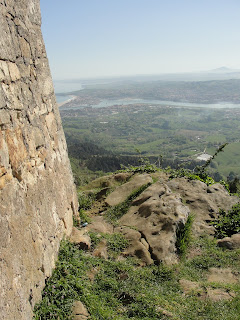
The sun was hot, and the way was long, though not particularly difficult once the initial climb had been achieved. The trail was mostly over open fields, some containing tough looking little horses. Almost always, I could see the ocean to my right. I did my usual first day foot pampering, changing my socks and applying Vaseline to my feet. At one concrete cross, I had a little lie down, and drank the last of my water. There was no explanation as to why the cross was there, but I had a pretty shrewd idea that it had something to do with the fallen of the Civil War. Other wars had left physical remnants too. The watchtowers were medieval, and one of them had been a rebel hideout in the Carlist wars of the mid-nineteenth century.
I decided not to go up to the fortress of Guadalupe at the very pinnacle, because it seemed an excessive climb if one was only going to drop down again. I decided to follow what looked to me like a yellow arrow off to the right. It turned out to be a flower. Eventually, after having to backtrack one field’s length, I found a stile and got onto a paved track, which ran between the sea and the hill on which the ruins of the fort are located. That suited me fine.
There were much older monuments than any of these forts. Along the ridge lay several ancient tombs, dolmens mainly. One of these, was most impressive, with a tall slab of stone on end in the centre. Someone had marked it with an inscription “Mendiabal“. As I learned later, Mendi means hill in the Basque language, Euskara. They had also marked it with a cross in a circle, which I found irritating, in the same way that the superimposition of a cross on the stone piles at Cruz de Ferro had bothered me. It seemed completely unnecessary, and in the case of the menhir, it struck my conservator’s mind as a defacement of an ancient monument.

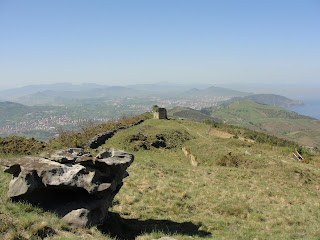
On the far side of the hill surmounted by the fortress, I could see San Sebastian in the distance. The way down the hill was precipitous, and I had to pick my way amongst boulders, and pay attention. The sun had started to beat me up a bit, and I was feeling the lack of water. My guidebook showed a village not too far away, so I was looking forward to some refreshment there. I was worried because it was getting close to two o’clock and everything would be shut. I needn’t have worried, because there was nothing there anyway except a couple of farms and a short street of houses. Everything had that hollow stillness of a place where no-one is home.
I was practically despondent, and definitely dehydrated by this point. I sat down in a small patch of shade by the garage of a shuttered house. I couldn’t walk another step.
I couldn’t believe my good fortune when, a few minutes later, I heard someone come out of the house. I scooted round to the steps leading up to the door and saw a woman, probably about my age, with her gardening gloves on. Apparently, it wasn’t just me and the mad dogs out at this time of day.
“Buenas tardes! Puedo pedirle de aqua, por favor?” Even in my semi-delirious state, I was proud of myself for getting the verb construction right! Of course, she was more than happy to help. I drank the entire bottle right down. How far is it to Pasaia? I asked.
She said that I was almost there, just had to go down some steps. Duh! Sure enough, just round the corner the steps down into Pasajes began, and continued for a couple of kilometres.




